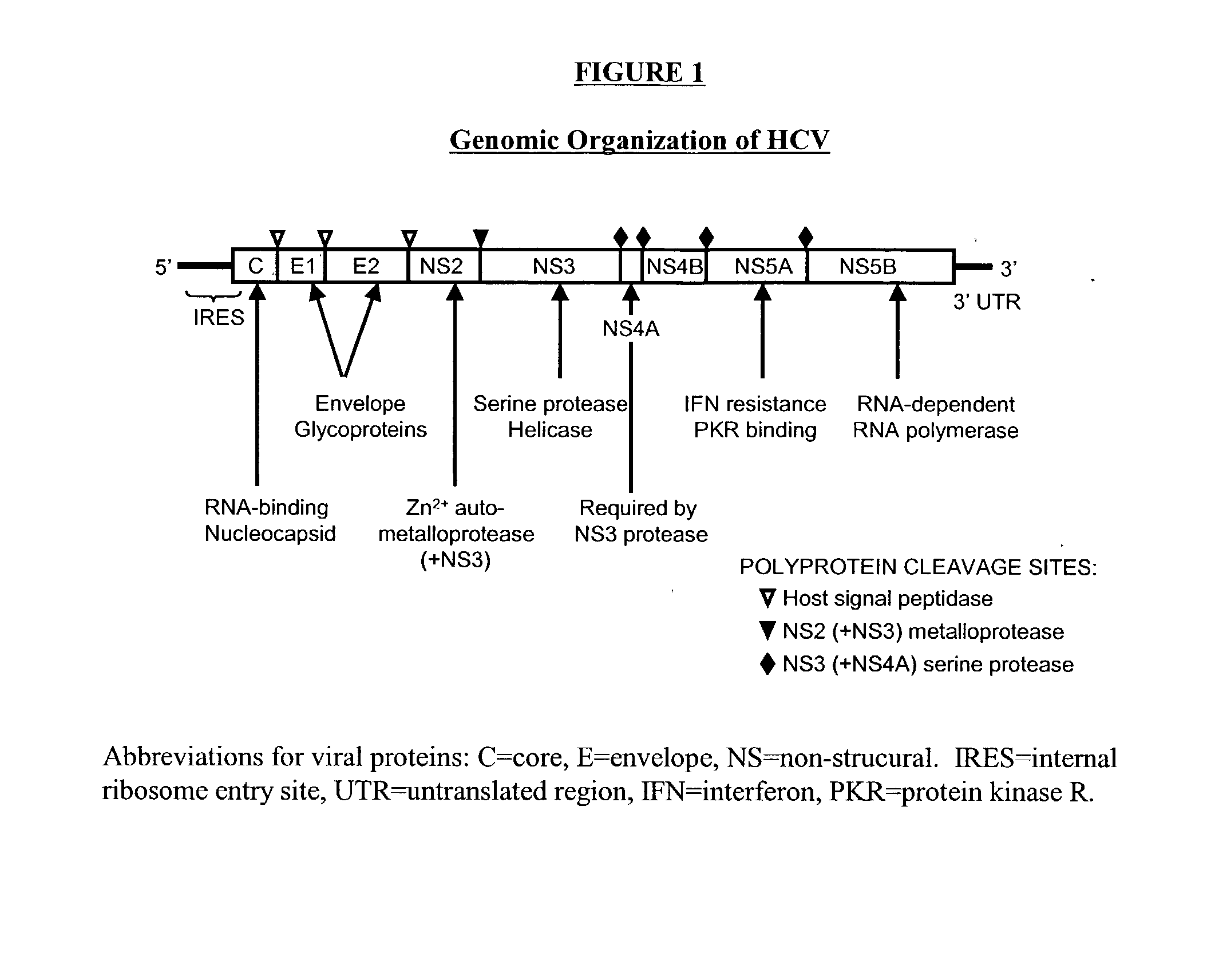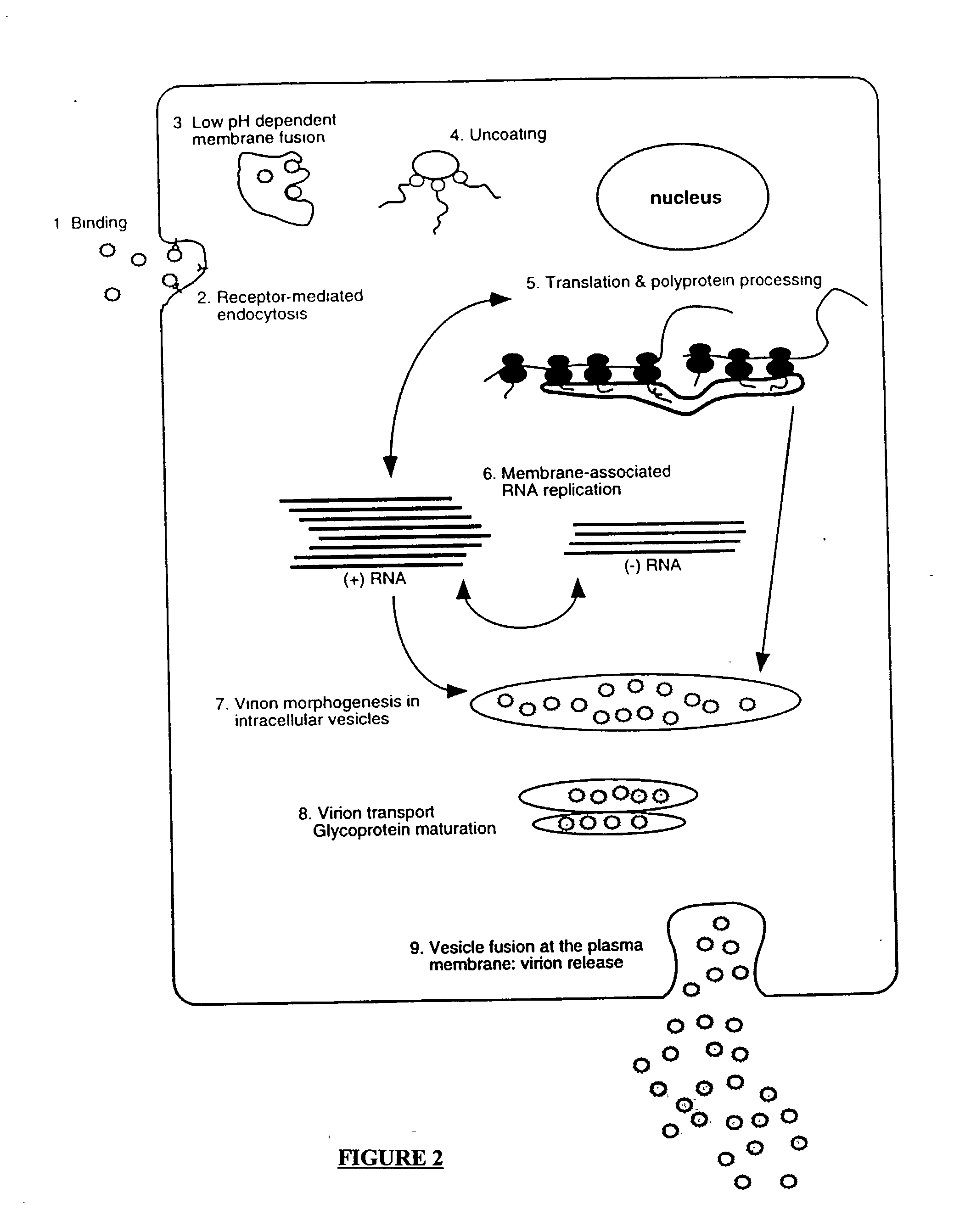Compositions and methods for determining susceptibility of hepatitis C virus to anti-viral drugs
a technology of antiviral drugs and compositions, which is applied in the direction of peptide/protein ingredients, peptide sources, instruments, etc., can solve the problems of no well established drug susceptibility assays for hcv, substantial drug resistance in pathogenic viruses, etc., and achieves the effects of reducing susceptibility, increasing the activity of indicator genes, and changing the activity of indicators
- Summary
- Abstract
- Description
- Claims
- Application Information
AI Technical Summary
Benefits of technology
Problems solved by technology
Method used
Image
Examples
second embodiment
[0175] In a second embodiment, the promoter is a promoter for bacteriophage RNA polymerases such as T7, T3, or SP6, and the terminator is a sequence signaling termination of transcription that is recognized by the polymerase, or a self-cleaving ribozyme (e.g., see Perotta et al., 1991, Nature 350:434-36; Chowrira et al., 1994, J. Biol. Chem. 269:25864; Wadkins et al., 2002, Cell Mol. Life Sci. 59:112-25). The IGVV is transfected as DNA into cells expressing the RNA polymerase in the cytoplasm. Such expression can be achieved by several methods including, but not limited to, cotransfection with a polymerase expression vector, infection with a recombinant vaccinia virus expressing the polymerase (Fuerst et al., 1986, PNAS 83:8122), and by previously establishing a cell line permanently expressing the polymerase (see FIG. 3C). In FIG. 3C, the DNA of a resistance test vector (pT7HCV-luc1) comprising the T7 RNA polymerase promoter and T7 RNA polymerase terminator is transfected into cell...
third embodiment
[0176] In a third embodiment, the IGVV with a bacteriophage RNA polymerase promoter at the 5' end and a terminator sequence at the 3' end is transcribed in vitro and the nucleic acid representing the IGVV is transfected as RNA. The terminator can be a specific sequence recognized by the bacteriophage RNA polymerase as a termination site or a self-cleaving ribozyme (see Perotta et al., 1991, Nature 350:434-36; Chowrira et al., 1994, J. Biol. Chem. 269: 25864; Wadkins et al., 2002, Cell Mol. Life Sci. 59:112-25), or, the terminator can be a restriction endonuclease site allowing for linearization of the DNA template prior to transcription (see FIG. 3D). FIG. 3D shows a resistance test vector (pT7HCV-luc2) comprising the T7 RNA polymerase promoter and a restriction site placed at the 3' end for linearization of the DNA prior to transcription in vitro. The synthetic RNA is then transfected directly into cells and translation and replication can occur. In this embodiment the vector also ...
example 1
6.1 EXAMPLE 1
Neomycin Replicons
[0322] This example demonstrates that replicons comprising the neomycin resistance-conferring gene are functional.
[0323] The HCV replicon system of FIG. 10 was used. These replicons had a neomycin resistance marker gene, such as the neomycin phosphotransferase gene (neo) in place of the sequences coding for the structural (C, E1, E2) proteins. Additionally, these replicons had the IRES from encephalomyocarditis virus (EMCV) inserted into the replicon to drive the translation of the HCV NS proteins.
[0324] Replication was demonstrated by the generation of cells that grew selectively in the presence of neomycin (G418) (Lohmann et al., 1999, Science 285:110-113). Individual replicons comprised the NS5B R2884G ("Adapt5B") adaptive mutation (see Lohmann et al., 2001, J Virol 75:1437-1449), or a combination of the NS3 E1202G, T1280I, and NS5A S2179P ("Adapt5.1") adaptive mutations (see Krieger et al., 2001, J Virol 75:4614-4624), or an NS5B polymerase inactiv...
PUM
| Property | Measurement | Unit |
|---|---|---|
| pH | aaaaa | aaaaa |
| temperatures | aaaaa | aaaaa |
| volumes | aaaaa | aaaaa |
Abstract
Description
Claims
Application Information
 Login to View More
Login to View More - R&D
- Intellectual Property
- Life Sciences
- Materials
- Tech Scout
- Unparalleled Data Quality
- Higher Quality Content
- 60% Fewer Hallucinations
Browse by: Latest US Patents, China's latest patents, Technical Efficacy Thesaurus, Application Domain, Technology Topic, Popular Technical Reports.
© 2025 PatSnap. All rights reserved.Legal|Privacy policy|Modern Slavery Act Transparency Statement|Sitemap|About US| Contact US: help@patsnap.com



